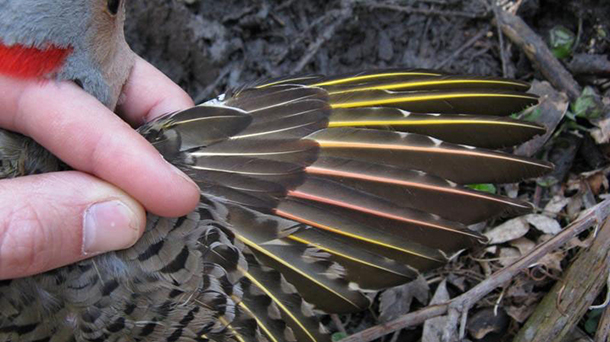Science Note: Yellow-Shafted Flickers See Red
Air Date: Week of February 24, 2017

Photo: A yellow-shafted flicker with red feathers. (Photo: Chris Hansen; courtesy of Rebecca Heisman, American Ornithological Society)
The North American woodpeckers known as flickers have red feathers under their wings in the west, and yellow feathers in the north and east. But some birds in the eastern range have been turning up with red-colored feathers. Scientists thought they were somehow breeding with their red-shafted cousins, but have now discovered they’re actually just feeding on red berries from the invasive Asian honeysuckle.
Transcript
CURWOOD: It's Living on Earth, I'm Steve Curwood. In a minute -- how Charles Darwin’s theories of evolution fanned the flames of America’s civil war, but first this note on emerging science from Don Lyman.
[SCIENCE NOTE THEME]
LYMAN: Northern flickers, medium-sized North American woodpeckers, come in two varieties -- red shafted in the west, and in the east and north yellow-shafted. The two names relate to the color of the feathers under their wings. But since the red and yellow flickers interbreed where their ranges meet, there are some birds with a salmon-pink blend of both colors.
For several years, ornithologists have documented some flickers in the east sporting red-orange wing feathers, and assumed that was due to interbreeding. But some of the yellow-shafted flickers with red feathers were thousands of miles east of the nearest red-shafted flickers.
Now scientists from the Royal Alberta Museum in Canada have solved the mystery. The red color in yellow-shafted flickers’ feathers is actually due to the birds eating red berries from invasive Asian honeysuckles. Using sophisticated optical laboratory techniques the scientists determined that a pigment in the berries called rhodoxanthin causes the red color in the eastern birds’ feathers, while it’s carotenoid pigments that make the western flickers’ feathers red.
Scientists think the berries also turn the tips of tail feathers of another bird species, the cedar waxwing, orange, instead of their normal yellow color.
This change in flicker feather color isn’t just an interesting curiosity. Scientists hypothesize that this new color variation could affect mate selection if the flickers can no longer rely on normal plumage color to signal a prospective mate’s body condition and fitness.
That’s this week’s note on emerging science. I’m Don Lyman.
[SCIENCE NOTE THEME]
Links
Audubon: “Mystery Solved: Invasive Berries to Blame for Turning Flickers’ Feathers Pink”
The Cornell Lab of Ornithology’s All About Birds: Northern Flicker
Living on Earth wants to hear from you!
Living on Earth
62 Calef Highway, Suite 212
Lee, NH 03861
Telephone: 617-287-4121
E-mail: comments@loe.org
Newsletter [Click here]
Donate to Living on Earth!
Living on Earth is an independent media program and relies entirely on contributions from listeners and institutions supporting public service. Please donate now to preserve an independent environmental voice.
NewsletterLiving on Earth offers a weekly delivery of the show's rundown to your mailbox. Sign up for our newsletter today!
 Sailors For The Sea: Be the change you want to sea.
Sailors For The Sea: Be the change you want to sea.
 The Grantham Foundation for the Protection of the Environment: Committed to protecting and improving the health of the global environment.
The Grantham Foundation for the Protection of the Environment: Committed to protecting and improving the health of the global environment.
 Contribute to Living on Earth and receive, as our gift to you, an archival print of one of Mark Seth Lender's extraordinary wildlife photographs. Follow the link to see Mark's current collection of photographs.
Contribute to Living on Earth and receive, as our gift to you, an archival print of one of Mark Seth Lender's extraordinary wildlife photographs. Follow the link to see Mark's current collection of photographs.
 Buy a signed copy of Mark Seth Lender's book Smeagull the Seagull & support Living on Earth
Buy a signed copy of Mark Seth Lender's book Smeagull the Seagull & support Living on Earth

